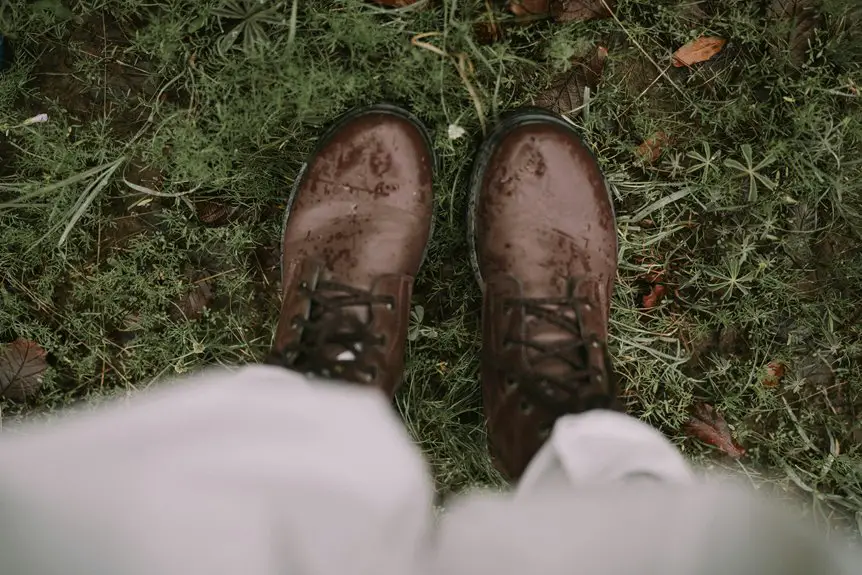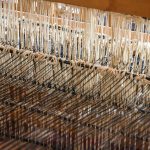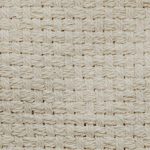Gabardine isn’t fully waterproof, but its tight twill weave does help repel light rain and moisture. You’ll find it resists water better than many other fabrics, keeping you comfortable and dry in mild showers. However, heavy rain or extended exposure can soak through, so gabardine is best for light to moderate wet weather. With proper care and water-resistant treatments, you can boost its performance. Keep exploring to understand how gabardine suits your rainy-day needs.
Table of Contents
Key Takeaways
- Gabardine has a tight twill weave that provides moderate water resistance but is not fully waterproof.
- It can repel light rain, but heavy or prolonged exposure will allow water to seep through.
- Water resistance improves significantly with treatments like durable water repellent (DWR) or wax coatings.
- Gabardine remains breathable, making it comfortable for wet weather gear like trench coats and jackets.
- Proper care, including regular reapplication of water-repellent finishes, is essential to maintain its weather resistance.
What Is Gabardine Fabric?
Gabardine fabric is a tightly woven material known for its durability and smooth finish. When you touch it, you’ll notice its distinctive twill weave, which creates diagonal ribs across the surface. This structure not only adds strength but also gives gabardine a sleek appearance that’s both professional and stylish.
You’ll find gabardine made from various fibers like wool, cotton, or synthetic blends, each offering unique benefits. Because of its tight weave, gabardine resists wrinkles and holds its shape well, making it a popular choice for tailored garments such as suits, trousers, and outerwear.
While it’s sturdy and smooth, gabardine isn’t inherently waterproof, but its construction helps provide some natural resistance to wind and light moisture.
How Is Gabardine Made?
Creating this fabric involves weaving fibers tightly together using a distinctive twill weave technique. You’ll find gabardine made primarily from wool, cotton, or synthetic fibers, each chosen for durability and comfort. The weaving method produces a smooth, tightly woven surface with diagonal ribs, giving gabardine its signature texture and strength.
Here’s a quick look at how gabardine is made:
| Step | Description |
|---|---|
| Fiber Selection | Choose wool, cotton, or synthetics |
| Twill Weaving | Use a tight twill weave pattern |
| Finishing | Apply treatments for smoothness |
This process results in a fabric that’s both sturdy and comfortable, ready for versatile uses.
The Tight Weave: Does It Keep Water Out?
Although the tight twill weave helps repel some moisture, it doesn’t make the fabric fully waterproof on its own. When you wear gabardine, the closely woven fibers create a dense barrier that slows water penetration. This means light rain or mist might bead up and roll off the surface rather than soaking through immediately.
However, if the rain intensifies or lasts longer, water can eventually seep in because the weave isn’t sealed. You shouldn’t expect gabardine to keep you dry in heavy downpours without additional treatment.
Its strength lies in providing moderate water resistance while remaining breathable and comfortable. So, while the tight weave offers some protection, it’s best to combine gabardine with waterproof coatings or layers if you need real defense against wet weather.
Gabardine vs. Other Waterproof Fabrics
When comparing gabardine to other waterproof fabrics, you’ll notice it offers moderate water resistance without sacrificing breathability.
Unlike fully waterproof materials like Gore-Tex or rubberized fabrics, gabardine’s tightly woven twill allows some air and moisture vapor to escape, keeping you comfortable in mild wet conditions.
However, it won’t keep you dry in heavy downpours like synthetic waterproof membranes do.
Compared to coated nylons or polyesters, gabardine feels more natural and drapes better, making it ideal for stylish outerwear.
Still, if you need maximum waterproofing for outdoor adventures, gabardine alone mightn’t be enough.
It strikes a balance between water resistance and comfort, so you can rely on it for light rain but consider other fabrics for serious weather protection.
Treatments That Enhance Gabardine’s Water Resistance
You can boost gabardine’s water resistance with several effective treatments.
Durable water repellent coatings, wax and silicone treatments, and even advanced nano-technology finishes all work to keep moisture at bay.
Let’s explore how each of these enhances gabardine’s waterproof performance.
Durable Water Repellent Coatings
Since gabardine naturally resists water to some extent, applying durable water repellent (DWR) coatings can greatly boost its performance in wet conditions.
These coatings create a thin, invisible layer on the fabric’s surface that causes water to bead up and roll off instead of soaking in. When you use gabardine treated with DWR, you’ll notice it stays drier longer during light rain or damp weather.
While DWR doesn’t make the fabric fully waterproof, it markedly enhances its resistance to moisture without compromising breathability or texture.
Over time, you might need to reapply DWR treatments, especially after washing, to maintain this water-shedding ability. This simple step can extend gabardine’s usability in wet environments, making it a smarter choice for unpredictable weather.
Wax and Silicone Treatments
Two popular treatments that greatly boost gabardine’s water resistance are wax and silicone coatings.
When you apply these treatments, they create a protective barrier that repels water while maintaining the fabric’s breathability. Wax adds a natural, durable layer that you can refresh over time, perfect for outdoor gear. Silicone treatments, on the other hand, offer a lightweight, flexible shield that resists moisture without stiffening the fabric.
Here’s what you should know about these treatments:
- Wax treatments provide a rugged, long-lasting water barrier.
- Silicone coatings keep gabardine soft and flexible.
- Both require reapplication to maintain effectiveness.
- Wax might darken the fabric slightly, while silicone preserves its original look.
Using these, you can enhance gabardine’s weather resistance considerably.
Nano-Technology Fabric Finishes
While wax and silicone treatments have long been go-to options for boosting gabardine’s water resistance, advancements in nano-technology have introduced even more effective fabric finishes.
These finishes create an invisible, ultra-thin protective layer that repels water without affecting the fabric’s breathability or softness. When you apply a nano-technology finish, water beads up and rolls off instantly, preventing absorption and stains.
Unlike traditional coatings, these treatments bond at the molecular level, offering longer-lasting protection that withstands multiple washes. Plus, they maintain gabardine’s natural feel and appearance, so you won’t sacrifice style for function.
If you want your gabardine garments to perform better in wet conditions without extra weight or stiffness, nano-technology finishes are a smart, modern solution you should definitely consider.
Common Uses of Gabardine in Rainwear
Although gabardine mightn’t be the first fabric that comes to mind for rainwear, its tightly woven structure and water-resistant finish make it a popular choice for trench coats, blazers, and umbrellas.
Gabardine’s tight weave and water-resistant finish make it ideal for stylish, functional rainwear essentials.
If you want reliable protection without sacrificing style, gabardine fits the bill perfectly. Here are some common uses of gabardine in rainwear you might consider:
- Classic trench coats that keep you dry and sharp.
- Lightweight blazers suitable for drizzly days.
- Durable umbrellas resistant to water and wind.
- Rain hats that combine fashion with function.
When you choose gabardine, you get a fabric that balances water resistance and breathability, making it great for unpredictable weather.
It’s a smart option for your rain-ready wardrobe.
Caring for Gabardine to Maintain Its Weather Resistance
To keep your gabardine weather-resistant, you should follow proper washing techniques that protect its fabric finish.
Store it in a cool, dry place to maintain its longevity and shape.
Don’t forget to reapply water-repellent coatings regularly to guarantee it stays effective against rain and moisture.
Proper Washing Techniques
Since gabardine’s weather resistance depends largely on its treatment, you’ll want to wash it carefully to preserve its waterproof qualities.
Improper washing can strip away protective coatings, reducing its ability to repel water. Follow these steps to keep your gabardine in top shape:
- Use cold water and a mild detergent to avoid damaging fibers and treatments.
- Hand wash or select a gentle cycle on your washing machine to minimize agitation.
- Avoid fabric softeners and bleach, as they can break down the water-resistant finish.
- Air dry your gabardine by laying it flat or hanging it up; don’t use a dryer, which can degrade the fabric’s performance.
Sticking to these techniques helps maintain gabardine’s durability and weather resistance over time.
Storage Tips for Longevity
When you store gabardine properly, you help preserve its water-resistant finish and extend its lifespan.
Always hang your gabardine garments on wide, padded hangers to maintain their shape and avoid creases that can weaken fibers. Keep them in a cool, dry place away from direct sunlight, as UV rays can degrade the fabric and its finish.
Avoid overcrowding your closet; allow enough space for air circulation to prevent moisture buildup, which can lead to mildew. If you need to fold gabardine, do so gently along natural seams and avoid sharp creases.
Finally, store your gabardine away from strong odors and chemicals that could damage the fabric. Following these simple steps keeps your gabardine looking sharp and weather-resistant longer.
Reapplying Water-Repellent Coatings
Although gabardine’s water-repellent finish is durable, it will gradually wear off with regular use and washing.
To keep your gabardine weather-resistant, you’ll need to reapply a water-repellent coating periodically. Here’s how you can do it effectively:
- Clean the fabric thoroughly to remove dirt and oils before applying the coating.
- Choose a spray-on or wash-in water repellent designed specifically for gabardine or similar fabrics.
- Apply the coating evenly, following the product instructions closely for the best results.
- Allow the garment to dry completely, preferably air drying away from direct heat or sunlight.
When to Choose Gabardine for Wet Weather Gear
You’ll find gabardine works best for wet weather gear when you need a fabric that combines durability with a sleek, water-resistant finish.
It’s ideal for raincoats, trench coats, and lightweight jackets where you want protection without bulk. Gabardine’s tight weave naturally repels water, making it suitable for light to moderate rain.
Choose gabardine if you prioritize breathability alongside weather resistance, as it’s more comfortable than fully waterproof materials in mild wet conditions.
Gabardine offers breathable comfort with reliable weather resistance for mild wet conditions.
However, avoid it in heavy downpours or prolonged exposure to water since it’s not fully waterproof.
If you want stylish, functional outerwear that handles everyday wet weather well, gabardine is a smart choice.
Just remember to maintain its water resistance by occasional treatment with a water-repellent spray.
Frequently Asked Questions
Is Gabardine Breathable Despite Its Water Resistance?
Oh sure, gabardine’s basically a sauna suit with a raincoat’s ego. You’ll stay dry but might sweat—it’s water-resistant, not a magic breeze. So, don’t expect full breathability; it’s a trade-off, friend.
Can Gabardine Fabric Be Recycled or Is It Eco-Friendly?
You can recycle gabardine if it’s made from natural fibers like cotton or wool, but synthetic blends complicate that. While it’s durable and long-lasting, its eco-friendliness depends on materials and production methods used.
How Does Gabardine Perform in Extreme Cold or Heat?
Did you know gabardine’s tight weave blocks about 70% of wind? In extreme cold, it keeps you warmer, but in intense heat, it might feel heavy since it’s less breathable. So, wear it wisely!
Does Gabardine Shrink After Washing or Exposure to Water?
You might notice gabardine can shrink slightly if you wash it in hot water or dry it aggressively. To keep it fitting well, you should wash gently in cold water and air dry whenever possible.
Are There Different Types of Gabardine for Various Climates?
Oh sure, because one gabardine fits all climates like a magic cloak! Actually, you’ll find lightweight versions for summer and heavier ones for winter, so you’ll stay comfortable no matter what weather throws at you.
- Is Gabardine Waterproof? The Truth About Its Weather Resistance - June 23, 2025
- Wool Gabardine vs. Cotton Gabardine: Which Fabric Is Right for You? - June 23, 2025
- How to Wash Gabardine: A Step-by-Step Care Guide for All Fabric Types - June 23, 2025







